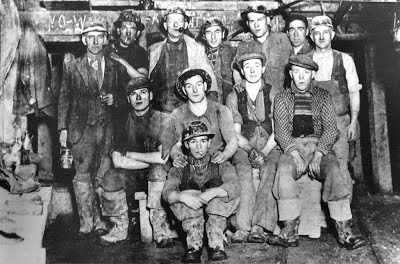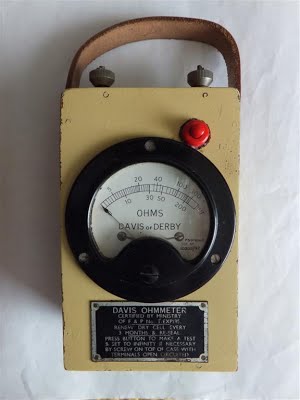|
Images
below are courtesy of Don Richardson (unless otherwise stated)
Halkyn
Miners in the 1930s. Location of workings unknown.
Anyone
recognise the place or the people?
Don Richardson was
electrician at Halkyn Mines from 1940 to 1987 when the mine finally
closed. Don managed to save a collection of photographs and papers
relating to the mine. He kindly agreed to talk about his years spent
underground with the writer in 2011, and also permitted the copying of
his collection. The majority of the photos are shown, with Don's
consent, on this page. Some are unique images from the 1930s and may not
have been seen before.........
Notes
taken during a conversation with
Don
Richardson at his home in Holywell
Sept 8th 2011
Don was
aged 86 at the time of the visit. His memories were clear and he was happy
talking about his years at Halkyn Mines.
It was
first pointed out that “The Milwr Tunnel” book had two errors which Don
wished to correct:
The book
wrongly states that the round tallies were used at Olwyn Goch Shaft and
the hexagonal tallies at Pen-y-Bryn. Both tallies were actually used at
both shafts: Each miner had their own round tally, which they used when
clocking on. The hexagonal tallies were then picked off the rack by each
miner before entering the cage. These were picked in numerical order. At
the end of shift, men were taken up the shaft in the same order as they
went down, thus encouraging men to arrive promptly at the start of each
shift.
The wooden
galvanometer shown in the book was not of the type used by Halkyn Mines.
Don produced his own ohmmeter as used at the mine (image below).
Halkyn
Mines ohmmeter used to test shot wiring before blasting
Don began
work for Halkyn Mines at the age of 15 in 1940 following his father
Alberts footsteps. Albert moved from Staffordshire as an overman to work
at Bettisfield Colliery and later joined Halkyn Mines. Don's father is
pictured in the photo on page 20 in “The Milwr Tunnel” 2nd edition,
shown below (bottom right). Other people remembered by Don in the same
photo are back row, from the left: Cecil Lloyd, Mr Powell, Ben Casey.
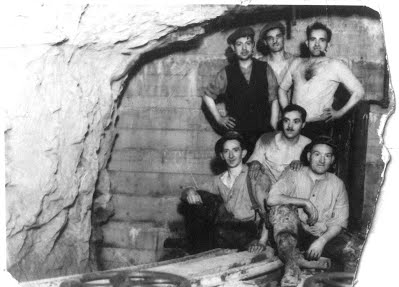
120ft
below tunnel level, prior to blasting into the lake at Powell's
lode. Photo: Glynn Morris
The large
galvanised tanks above Powell's Shaft stored water used for cooling the
large compressor installed at tunnel level below. When installing the
pumping machinery in Powell's Lode at -120ft below tunnel level, a
submarine torpedo tube was installed between the new pumps and the rock
face prior to the final blasting through to the lake.
Several
German Prisoners of War were employed by Halkyn Mines. Amongst these
were Walter Blok of Mold and Herbert Jagusch. Herbert married a girl
called Maude, also from Mold. Although now living in Germany, they
return each year to visit friends and relatives and he maintains a keen
interest in local mining.
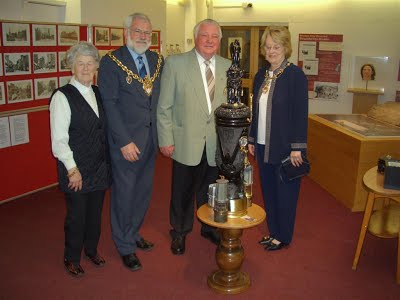
Herbert
Jagusch and his wife Maude pictured with one of his superb anthracite
carvings.
The
carving was presented to Wrexham Museum who have held it in storage ever
since!
Photo: Cris Ebbs
When the
Milwr Tunnel reached Cadole in 1957, driving was finally stopped. The USA
had been stockpiling ore but released in onto the market causing a slump
in UK prices. Halkyn Mines continued producing ore that went for smelting
to Walker, Parker in Chester, but the operation was then losing money.
With ore
prices being so low, the mine began quarrying a pure form of limestone.
The main extraction area at Hendre known as 'The Quarry', had two main
tunnels connecting the many chambers, one known as Catholics, the other
as Protestants.
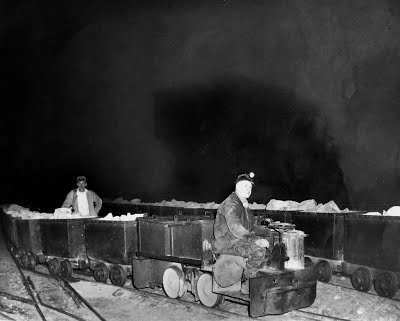
Limestone
extraction at "The Quarry"
At
Pen-y-Bryn Shaft in 1937 an experimental melting (not smelting) plant was
installed. The company used the plant to separate brass from builders
waste. The brass was then made into ingots of approximately 15” x 4” x 4”.
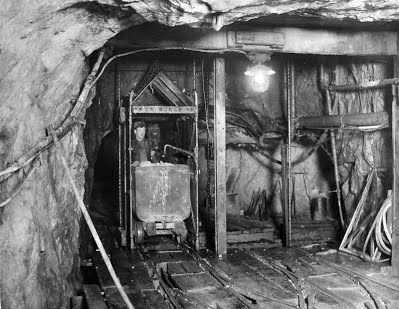
Pen-y-Bryn shaft bottom in the 1930s
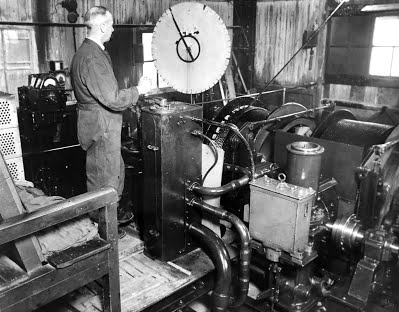
Pen-y-Bryn shaft winder 1930s
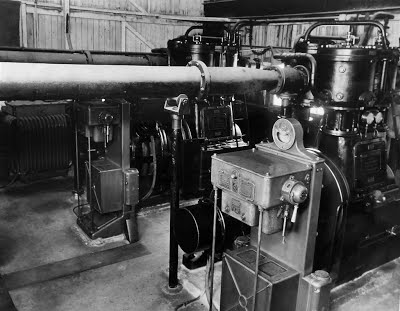
Pen-y-Bryn shaft compressor 1930s
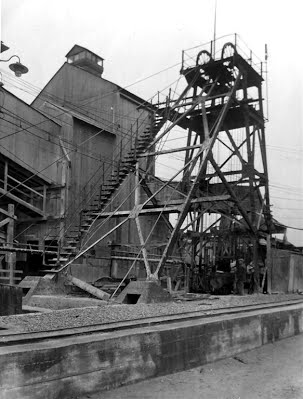
Pen-y-Bryn shaft headframe 1930s
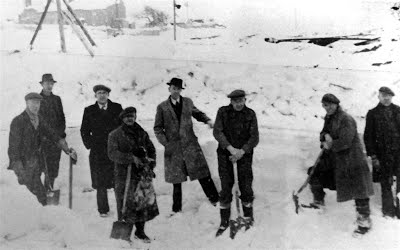
Clearing snow at Pen-y-Bryn
Water
for processing on the surface at Pen-y-Bryn Shaft was supplied by a pump
installed in a sump close to the bottom of the shaft. Pen-y-Bryn Shaft
was stripped out in 1980 when the hoist was taken by Greenfield Heritage
Centre. The main drive shaft for the winder now lies at the entrance to
the centre (image below).
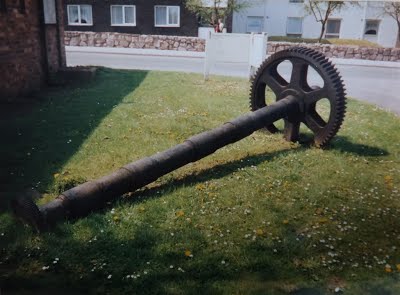
Pen-y-Bryn main drive shaft at Greenfield
Before the
mine finally closed in 1987, the workforce of just six men were given the
job of filling or capping many of the open shafts at surface. A company
director arrived to see a shaft being treated and was taken to Conquerer
of Wales Shaft near Pantymwyn. When invited to take a closer look down the
shaft he declined, commenting “It's too dangerous”. When Don Richardson
was told of this, he pointed out that if it was too dangerous for the
director, then it was too dangerous for the men, and requested danger
money. Mine Manager Mr Bowstred agreed and a phone call later the men were
offered £20 each per shaft on top of their wages.
The
brick chimney next to the adit entrance of Olwyn Goch Shaft (image
below) originally served a steam winder at the shaft. When the mine
finally closed, Don was asked to burn many unwanted company documents at
the foot of the chimney. Recognising the importance of some, he asked if
he could keep a selection of photographs.
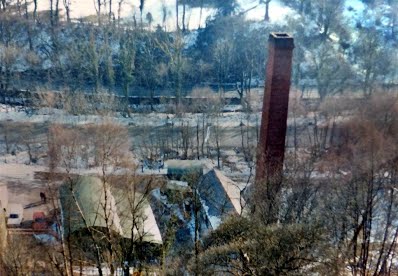
Olwyn Goch shaft chimney
Don stated that
Halkyn Mines was a very happy work place (confirming the statement by
John Bellis). Although Don was an electrician, he undertook many
different jobs as needs dictated.
When McNabb left the
company, he left his Triumph motorbike, which was in good condition, and
never returned for it.
In 1953 at Olwyn Goch
Shaft a fatality occurred. A guide wire in the shaft had broken and as a
result the cages were not operating. Men therefore had to climb the
ladders in the shaft. One man suffered a heart attack part way to
surface and died on the spot.
Together with those
above, the following photographs represent most of the Richardson
collection.......
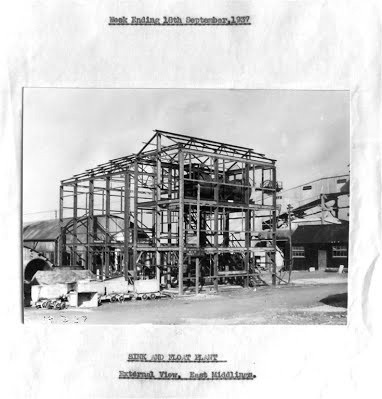
Pen-y-Bryn mill 1937
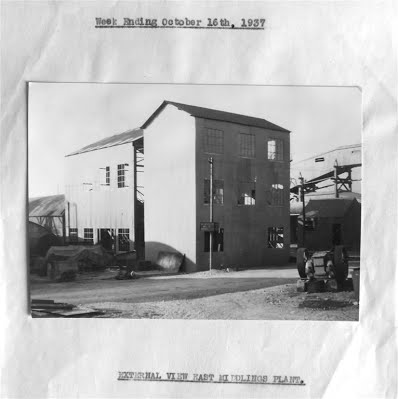
Pen-y-Bryn mill 1937
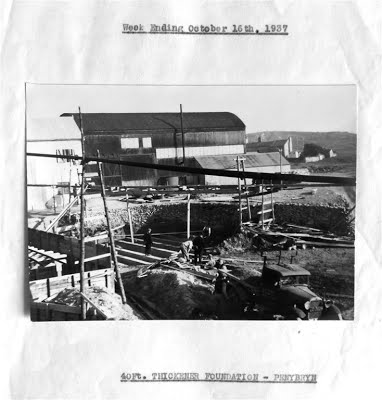
Pen-y-Bryn mill 1937
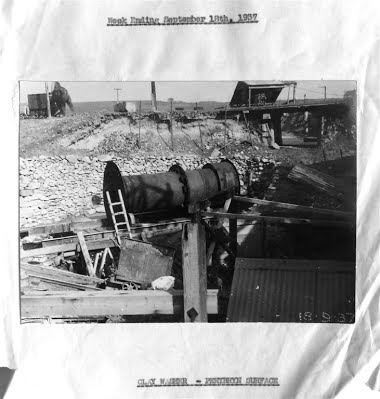
Pen-y-Bryn mill 1937
As the Milwr Tunnel advanced southwards, it became necessary to move the
surface milling complex. In 1934, operations moved from Pen-y-Bryn Shaft
at Halkyn, to Olwyn Goch Shaft at Hendre. Subsequently, Cae Mawr Shaft at
Pantymwyn was prepared as a main hauling shaft. But although a winding
shed and headframe were completed, the project was abandoned. The
following four photographs show Cae Mawr Shaft during being prepared.....
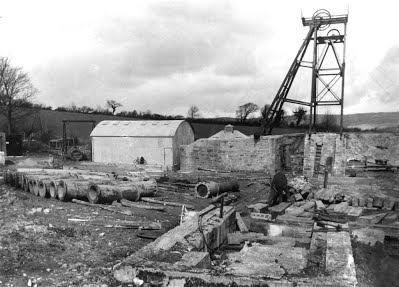
Cae Mawr Shaft, Pantymwyn 1937
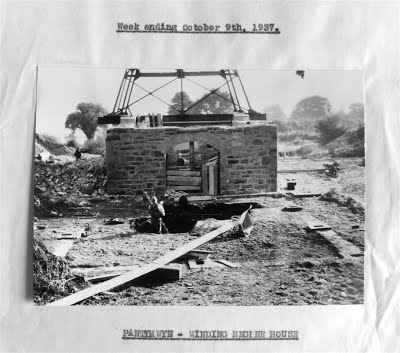
Cae Mawr Shaft, Pantymwyn 1937
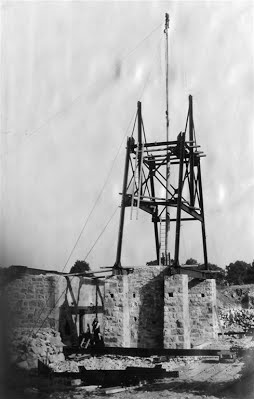
Cae Mawr Shaft, Pantymwyn 1937
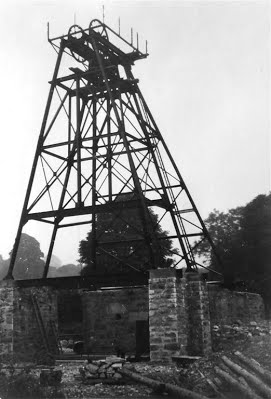
Cae Mawr Shaft, Pantymwyn 1937
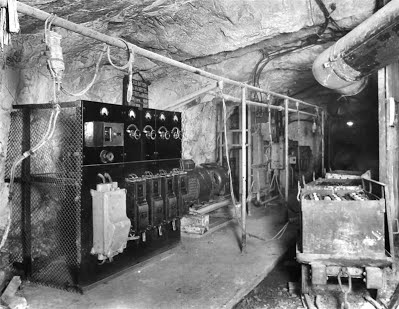
Olwyn Goch shaft charging bay
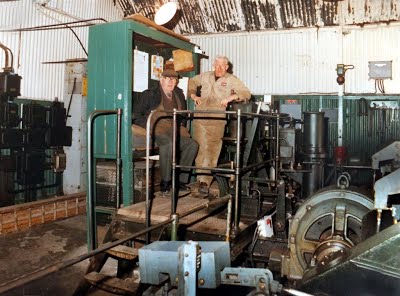
Olwyn Goch shaft winding shed. Don Richardson and Cyril
Jones
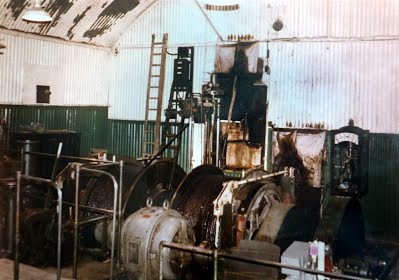
Olwyn Goch shaft winding shed
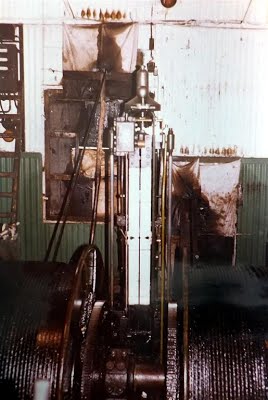
Shaft speed indicator at Olwyn Goch winding shed.
Speeds over 12 feet a second triggered a bell to ring.
If the speed was not slowed down by the winch operator, power to the
winch was cut off.
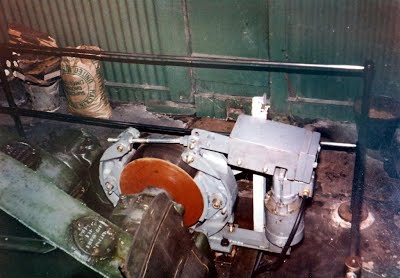
Olwyn Goch shaft winding shed
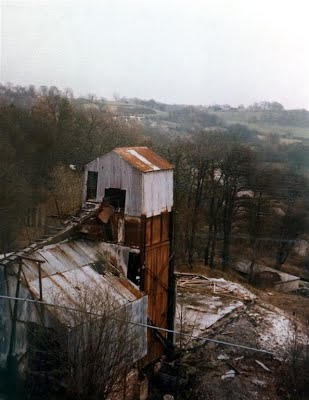
Olwyn Goch shaft mill
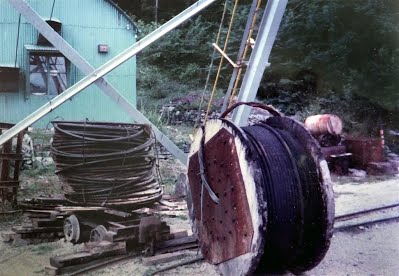
Dismantling of Olwyn Goch winding shed and headframe
1987
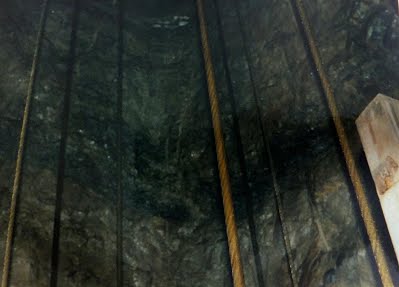
Guide wires in Olwyn Goch shaft
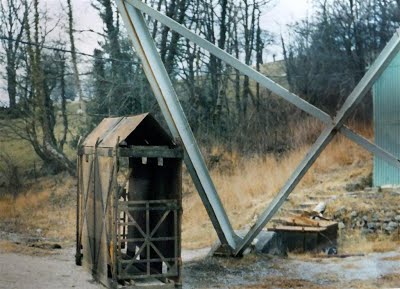
Shaft cage removed from Olwyn Goch shaft 1987
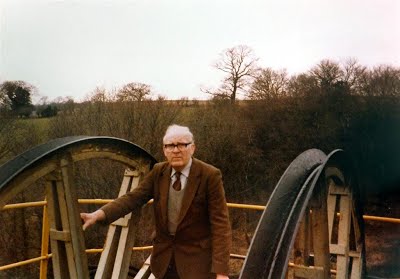
Don
Richardson during the dismantling work at Olwyn Goch 1987
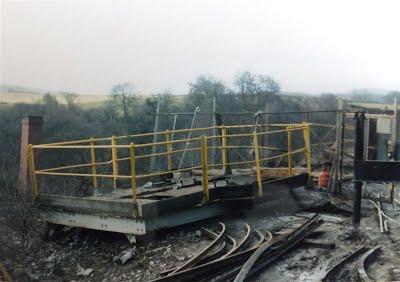
Top of Olwyn Goch headframe after dismantling 1987
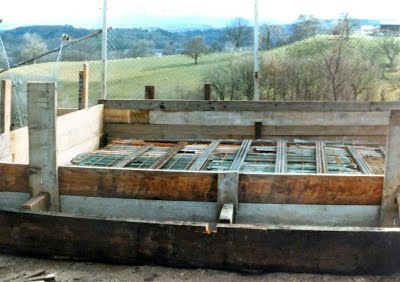
Sealing
of of Olwyn Goch shaft 1987
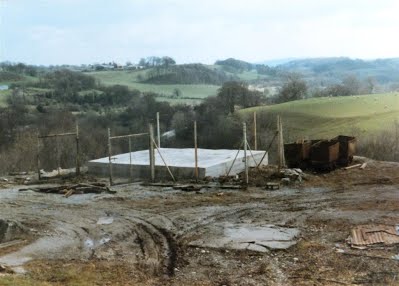
Sealing of of Olwyn Goch shaft 1987
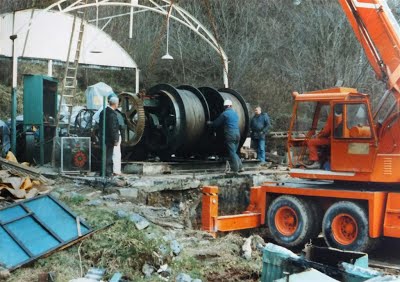
Dismantling of Olwyn Goch winding shed 1987
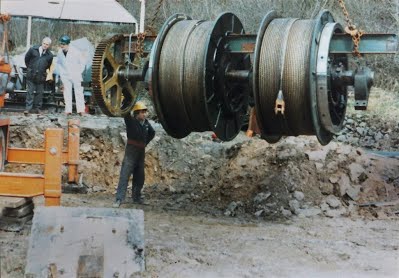
Dismantling of Olwyn Goch winding shed 1987
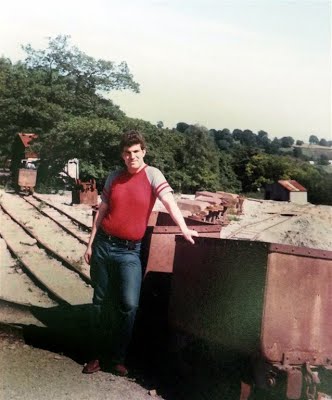
Don's son Robin Richardson at Olwyn Goch Shaft 1987
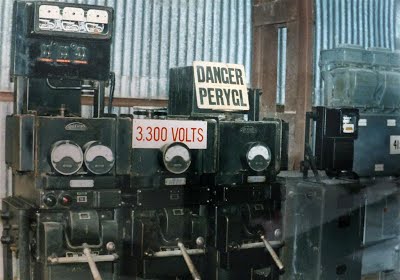
Olwyn Goch sub-station 1987
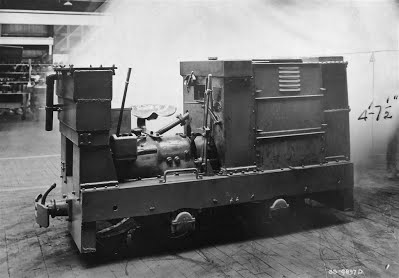
New diesel loco ready for service at Olwyn Goch
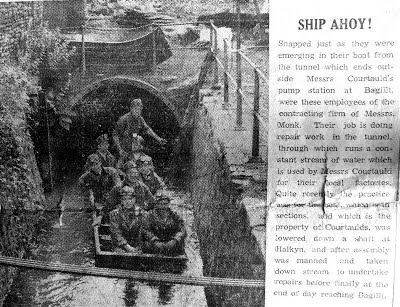
Maintenance team exiting Milwr Tunnel portal. From a
newspaper article
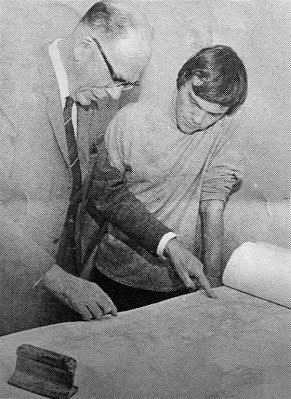
Mine Manager Mr Bowstred and a student from Leeds
examining mine plans
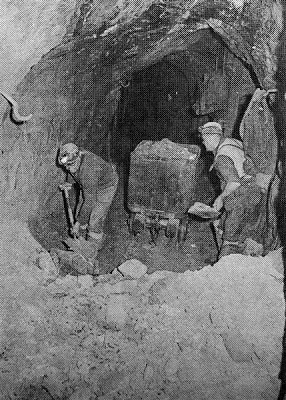
Mucking out in Lode 530 (Pant-y-Buarth Lode)
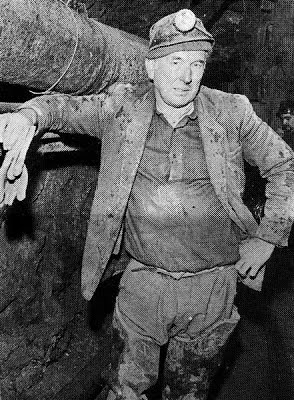
Foreman John Bellis
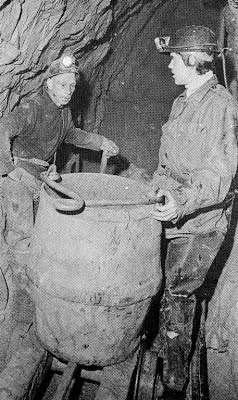
Loading a kibble in Lode 530 below tunnel level
? and Jim Hoole (on right)
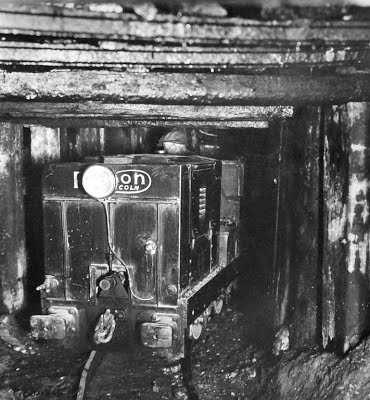
The location of this photograph is uncertain, but could be the Rhosesmor
Branch of the Milwr Tunnel

With sincere thanks to Don Richardson for his kindness and generosity
|
